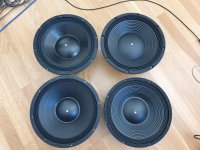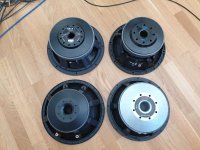The AXi is 8ohms, wish they had a 16ohm version.
I have one baffle installed on each sub, to install the second baffles I have to install one woofer with screws....then glue in the opposing baffle....with a woofer in it,as well...once thats locked up, I can remove screws and insert the threaded rods....then I'll finish covering them with mortar.
Need to pick up some gasketing tape also...John uses it...so if the designer of your drivers uses it...you use it too lol.
I have one baffle installed on each sub, to install the second baffles I have to install one woofer with screws....then glue in the opposing baffle....with a woofer in it,as well...once thats locked up, I can remove screws and insert the threaded rods....then I'll finish covering them with mortar.
Need to pick up some gasketing tape also...John uses it...so if the designer of your drivers uses it...you use it too lol.
You guys have a favorite gasket tape? or another method you like a lot to keep me from having to order gasket tape from dayton ohio?
https://www.menards.com/main/buildi...609-c-5713.htm?tid=5248562715127738221&ipos=1
butyl tape maybe?
https://www.menards.com/main/buildi...609-c-5713.htm?tid=5248562715127738221&ipos=1
butyl tape maybe?
Last edited:
Comparing Fulcrum's FH and AH Coaxial Horn Systems - YouTube
I fancy this type of enclosure to turn a pair of 15"s into a horn...and then stick the axi and its horn in the middle...
How does one go about calculating the output frequency where it begins to see an object directly in its output path...obviously lower is better...but I'm thinking ok if the tweeter horn was say 15" wide...how low would one have to cross to keep the output from seeing this object?
I want to say 13550/15/4
= 225.83333333333333333333
I fancy this type of enclosure to turn a pair of 15"s into a horn...and then stick the axi and its horn in the middle...
How does one go about calculating the output frequency where it begins to see an object directly in its output path...obviously lower is better...but I'm thinking ok if the tweeter horn was say 15" wide...how low would one have to cross to keep the output from seeing this object?
I want to say 13550/15/4
= 225.83333333333333333333
And I finally, I was looking for the comment where I thought Tom suggested for me to use gasket tape?....but I reread that email and it says nothing of gasket tape....
I don't need gasket tape for these woofers I bet *face palm*
I don't need gasket tape for these woofers I bet *face palm*
Never seen this site before but prices look legit on the horns.
Interesting! Didn't know some of these were still available as a lot of them are inexpensive 'golden oldies' from way back when, some dating from the '60s, so best suited for vintage 'el cheapo' DIY PA/party type speakers.
You guys have a favorite gasket tape?
I only use NEMA 3R rated neoprene since it retains its 'sponginess' for many decades in all manner of wet weather over temperature extremes, so in the case of my Altecs that need periodic rotation I can use the same torque spec for decades with no fear of leaks.
Anyway, any quality neoprene for general use available at big box hardware or similar stores is what I normally recommend.
What's important regardless of what you use is to not drill/punch holes in it if possible, instead clamping the driver/baffle/whatever in place and use the appropriate torque for the hardware, or if practical, industrial double stick tape it together.
Regarding my Subwoofer building using threaded rod to connect he woofers and for bracing...
I had to reverse a threaded rod because I forgot to put a nut in and I snapped a threaded rod, they are aluminum because I followed the idea the same as using aluminum or SS screws for a compression driver to not mess with the magnets? (SS threaded rod is crazy expensive at 36" long)
Am I doing too much? Will the normal zinc coated steel threaded rods be acceptable?
I had to reverse a threaded rod because I forgot to put a nut in and I snapped a threaded rod, they are aluminum because I followed the idea the same as using aluminum or SS screws for a compression driver to not mess with the magnets? (SS threaded rod is crazy expensive at 36" long)
Am I doing too much? Will the normal zinc coated steel threaded rods be acceptable?
It's what I used way back when, though admittedly the '70s - '90s era woofers were either powerful prosound or fairly inexpensive, wimpy motored devices [no true sub regardless how low its Fs] and can't recall if there was any issues with the rods being strongly pulled towards the motor at this late date, so pretty sure it wasn't an issue.
Mostly folks were concerned over these 12-24" dia. monoliths distorting the CRT TV's picture and of course computer CRT monitors later on, so did some quickie testing to prove that AlNiCo wasn't an issue and the rest only needed a 12 ga galvanized steel plate ~4x [IIRC] the tube's gun area between them. Thinner may work too, but didn't have any scrap.
If there's a problem with mega power motors, I imagine the plates around the driver will work or maybe even galvanized steel tubes slid down over the rods will suffice.
Mostly folks were concerned over these 12-24" dia. monoliths distorting the CRT TV's picture and of course computer CRT monitors later on, so did some quickie testing to prove that AlNiCo wasn't an issue and the rest only needed a 12 ga galvanized steel plate ~4x [IIRC] the tube's gun area between them. Thinner may work too, but didn't have any scrap.
If there's a problem with mega power motors, I imagine the plates around the driver will work or maybe even galvanized steel tubes slid down over the rods will suffice.
Last edited:
Wooden dowels would be acceptable, and would not ring like a long metal rod...Regarding my Subwoofer building using threaded rod to connect he woofers and for bracing...
Am I doing too much? Will the normal zinc coated steel threaded rods be acceptable?
Thank you for the reassurance GM
Your experience coincides with planet10's as well
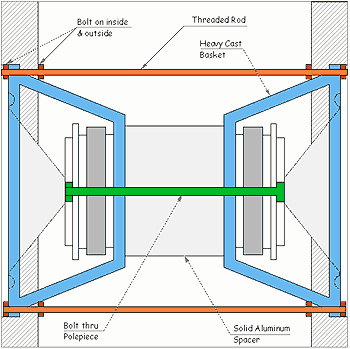
I returned the aluminum rod, removed the broken one, and after like 4 trips to menards I think I can move forward lol.
Your experience coincides with planet10's as well
I returned the aluminum rod, removed the broken one, and after like 4 trips to menards I think I can move forward lol.
Luckily we do not need to worry about magnets and CRTs anymore.
I remember putting a Class A amplifier next to a CRT and running a LF test and seeing the picture totally distort.
I remember putting a Class A amplifier next to a CRT and running a LF test and seeing the picture totally distort.
Wooden dowels would be acceptable, and would not ring like a long metal rod...
I think you see what I'm working with now, I'm running the rod through each woofer, through the whole cabinet. Attempting is a better word...hindsight says remove threaded rods except for on the baffles behind the woofers and use nuts and washer on the front/backside of the driver baffle.
wesayso's subwoofer build should give you some ideas on how it could be done with threaded rod
http://www.rsr-concepts.com/vandermill/?p=922
http://www.rsr-concepts.com/vandermill/?p=922
New kid on the cardiod block.
Finally one that doesn't rely on hifi drivers.
Specs:
- Wide and shallow baffle: 1100 x 480 x 185 mm (apx. 3.6 x 15.75 x 6 ft.)
- 44 mm (1.75") titanium compression driver + waveguide
- Midbass driver is a 250 mm (10") with an Nd-motor in a closed cabinet
- Additional bass is a 300 mm (12") mounted at the lower back in a ventilated cabinet (2x aerodynamic optimized ports)
- The overall concept is to shape directivity at every frequency in combination with the waveguide (heights), wide baffle (mids) and the cardioid pattern (bass)
- 1000W SMPS Class D per loudspeaker (Pascal)
- DSP filters are FIR based and linear-phase + limiters and dynamic-EQ.
Drivers are (most likely):
- Celestion CDX1-1740
- LaVoce WAN102.50(LD) (Front)
- BMS 12S305 (Rear).
Finally one that doesn't rely on hifi drivers.
Specs:
- Wide and shallow baffle: 1100 x 480 x 185 mm (apx. 3.6 x 15.75 x 6 ft.)
- 44 mm (1.75") titanium compression driver + waveguide
- Midbass driver is a 250 mm (10") with an Nd-motor in a closed cabinet
- Additional bass is a 300 mm (12") mounted at the lower back in a ventilated cabinet (2x aerodynamic optimized ports)
- The overall concept is to shape directivity at every frequency in combination with the waveguide (heights), wide baffle (mids) and the cardioid pattern (bass)
- 1000W SMPS Class D per loudspeaker (Pascal)
- DSP filters are FIR based and linear-phase + limiters and dynamic-EQ.
Drivers are (most likely):
- Celestion CDX1-1740
- LaVoce WAN102.50(LD) (Front)
- BMS 12S305 (Rear).
Attachments
-
 M2.png282.5 KB · Views: 280
M2.png282.5 KB · Views: 280 -
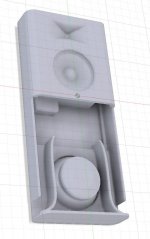 M2_Ports_inside.jpg33.4 KB · Views: 277
M2_Ports_inside.jpg33.4 KB · Views: 277 -
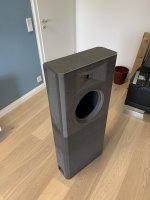 2-D2-F050-E-8030-4-B4-D-A049-71-D6-A3720-EA4.jpg403.8 KB · Views: 281
2-D2-F050-E-8030-4-B4-D-A049-71-D6-A3720-EA4.jpg403.8 KB · Views: 281 -
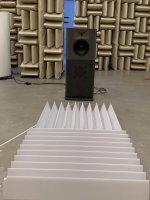 3729-B2-FD-4553-41-BE-96-EC-4-CC4287-A7688.jpg544 KB · Views: 275
3729-B2-FD-4553-41-BE-96-EC-4-CC4287-A7688.jpg544 KB · Views: 275 -
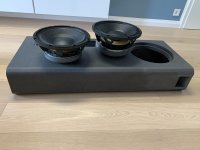 E4-A87-FFE-2-D0-B-4889-89-E2-34830-EC4-E9-F6.jpg771.4 KB · Views: 161
E4-A87-FFE-2-D0-B-4889-89-E2-34830-EC4-E9-F6.jpg771.4 KB · Views: 161 -
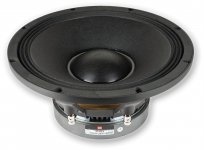 BMS_12S305_(Photo).jpg919.7 KB · Views: 121
BMS_12S305_(Photo).jpg919.7 KB · Views: 121 -
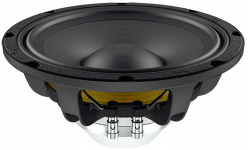 LaVoce_WAN102.50LD_(Photo).png495.5 KB · Views: 132
LaVoce_WAN102.50LD_(Photo).png495.5 KB · Views: 132 -
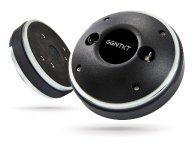 ModelM1_Hochtoener_Komposition.jpg59.5 KB · Views: 148
ModelM1_Hochtoener_Komposition.jpg59.5 KB · Views: 148
Last edited:
Yes, that's one of the drivers they've tested, like these 12s (the BMS, lower left, was selected):
Attachments
Last edited:
- Home
- Loudspeakers
- Multi-Way
- Is it possible to cover the whole spectrum, high SPL, low distortion with a 2-way?
